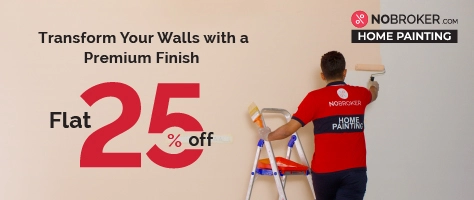Hi Buddy,
I was trying to enhance the security in my backyard by constructing a cement block. However, I was not very sure about the process of how to build with cement blocks wall. Hence, to assist me with the process I hired professionals. I witnessed the entire process and would like to share my experience with you guys.
To have your home painted or repainted at the lowest guaranteed prices, get in contact with the skilled painters of NoBroker.How to build wall with cement blocks?
- Footing plan
The projected concrete wall should have a footing that is twice as wide as the concrete being poured. Consequently, the footing needs to be at least 16 inches wide for an 8-inch-wide cinder block. When constructing the concrete wall footing, only use high-strength concrete. This is one of the main steps while considering how to build a cement block wall.
- Make a trench
Use a trenching tool or a trenching shovel to dig beneath the frost line in your region. Building above the frost line will result in frost heave, a situation where expanding soil forces structures erected on top to move and occasionally fail, if your area sees cold temperatures.
- distribute concrete
Concrete should be poured into the trench up to just below the frost line. If rebar is necessary, it must be put up such that concrete may be poured around it before the concrete is poured. Allow the concrete to set for two or three days. Depending on where the frost level is and how deep you dug your trench, the footing's thickness will vary, but it should be at least eight inches thick.
- Chalk line, snap
Draw a chalk line in the middle of the area where the bottom row of concrete blocks will go with the help of a helper. Next, snap two more lines, one on either side of the bottom row of blocks that you desired.
- Create two leads
Put one full-size block between the lines and dry fit it. In order to mimic the mortar that will later be filled in there, add a 3/8-inch spacer made of plywood at the end. The course should be dry-fitted till the very end. The two end blocks, or leads, should be removed after marking their places.
- For placing the blocks, use a high-strength mason's mortar mixture
Using the amount of water stated on the packaging, combine the mortar in a motorised mixer or masonry tub. By taking up some mortar and holding the trowel to the side, you can test the mortar. The mortar has reached the ideal consistency when most of it is still on the trowel.
- Set the mortar base
Spray the footing with a gentle mist from the garden hose. Lay two rows of mortar, each about 1 inch high by 1/2 inch wide, using the two outer chalk lines as a guide. In order to lay a course of 12 to 14 standard-size concrete blocks, an 80-pound bag of mortar mix is required.
- Put down Cinder Block Leads
For the first lead, force the cinder block down onto the mortar lines. The holes ought to be vertically oriented. At the opposite end of the wall, repeat the same for the other lead.
Firmly press down, but not so hard that the mortar protrudes from the sides. Use the bubble level to check all sides. The majority of modifications can be done by lightly tapping the block with the trowel handle. Use a rubber mallet to tap the block or press a scrap piece of two by four on it and use a hammer to apply more power.
- Complete Bottom Course
Continue with the bottom course in its entirety, frequently checking the blocks' tops and sides with the bubble level for levelness and plumbness. Keep the 3/8-inch space between each block the same. Use the trowel to butter the side of each block before laying it to ensure that it will adhere to the block next to it.
- Block Set Closure
A closure block will be placed in the final available slot in a course. The closure block should be placed flat after buttering both sides. Fill any extra space between joints with mortar if there is any.
- Beginning of second course
Two half-sized 8-inch blocks are placed at each end of the wall to start the second course.
Lay mortar over the bottom row of blocks in a manner akin to the mortar lines that were applied to the footing. Simply place the mortar along the blocks' two outside ridges; avoid placing it on the middle web. With the bubble level, verify for level and plumb before pressing the two end 8-inch blocks into place.
- Second course
On the second course, run a mason's string line along the tops of the 8-inch blocks. This will aid in preserving the straightness and uniform height of each row.
On the second course, the remaining blocks should be full size. So that joints fall in the middle of lower blocks, arrange them in a brickwork pattern. The wall becomes stronger and has more lateral stability because of this running bond.
Build the remaining courses as usual.
I would like to conclude here about how to build with cement blocks wall. I hope this helps:)
Read More:
How To Paint A Faux Concrete Wall Finish?Your Feedback Matters! How was this Answer?
Shifting, House?
✔
Lowest Price Quote✔
Safe Relocation✔
Professional Labour✔
Timely Pickup & Delivery
Intercity Shifting-Upto 25% Off
Check Prices

Intracity Shifting-Upto 25% Off
Check Prices

City Tempo-Upto 50% Off
Book Now
Related Questions
Related Questions in Build Extra Space
Most Viewed Questions
Recently Published Questions
Authors Of The Question

0 Total Answers








How to Build Wall with Cement Blocks?
ruchi
107 Views
1 Answers
2 Year
2022-07-11T21:01:26+00:00 2022-07-28T16:55:55+00:00Comment
Share